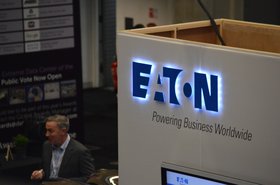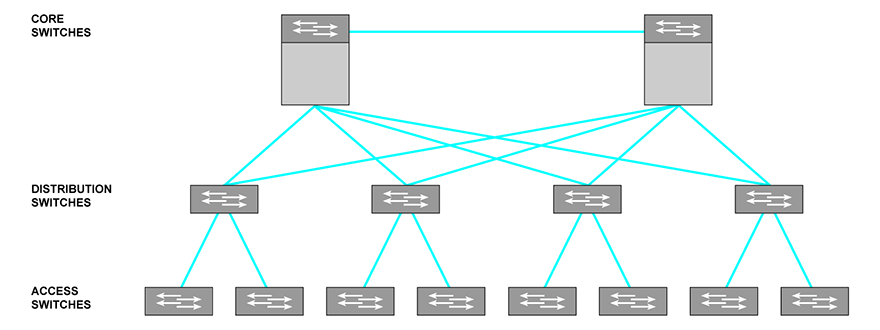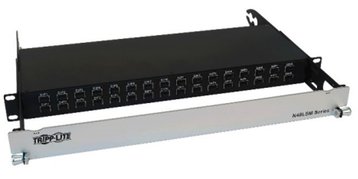The spine-and-leaf network architecture transcends the limitations of the traditional three-tier network architecture, delivering high bandwidth and low latency for server-to-server communications.
A standard method of connecting a spine-and-leaf network employs breakout cassettes and a dense web of fiber cross-connects, but this method increases cable clutter and installation errors. Purpose-built spine-leaf fiber patch panels overcome these challenges.
Traditional network architecture
Traditional data centers use a three-tier network architecture consisting of core switches, distribution/aggregation switches and access (aka top-of-rack or ToR) switches. This architecture is optimized for north-south communication between clients and servers.
The introduction of virtualization and other complex server applications has greatly increased server-to-server communications, however.
The traditional three-tier network architecture is unable to handle this increased east-west traffic efficiently because oversubscription leads to bandwidth bottlenecks and varying end-to-end routes introduce unpredictable latency.
Three tier network architecture is also prone to downtime because the failure of a single upstream switch can interrupt network access downstream.
Traditional network topology
Spine-and-leaf network architecture
The innovative spine-and-leaf architecture overcomes the limitations of the traditional three tier network architecture, delivering high bandwidth and low latency for server-to-server communications.
In the spine-and-leaf architecture, every lower-level access (leaf) switch is connected to every upper-level core (spine) switch in a full mesh.
Network traffic is evenly distributed among the spine switches, removing bandwidth bottlenecks. And since network traffic always traverses the same number of devices to go from leaf to leaf, latency becomes more predictable and manageable.
Network resilience is also improved, as spine switches are redundant by design and automatically compensate for switch failures. If the network requires more bandwidth, adding spine switches allows it to scale easily. And if more ports are required in the rack, another leaf switch can be added without downtime.
Spine-and-leaf network topology
Implementation challenges
A common method of connecting the spine-and-leaf network architecture uses breakout cassettes to separate the MTP/MPO ports on the network switches into individual lanes.
Fiber cables then connect every leaf switch to every spine switch in a mesh topology. As the mesh description implies, this requires a thick web of cabling.
For example, a network with eight leaf switches and four spine switches requires 32 fiber cables and 64 connections. (The number of leaf switches is limited by the port count of the spine switches, and the number of spine switches is limited by the uplink port count of the leaf switches.)
Complicated cabling increases the chance of installation errors, which are difficult and time-consuming to diagnose and troubleshoot. It also makes the network more difficult to upgrade or modify.
Simplifying installation
Spine-leaf fiber patch panels overcome these limitations with structured cabling. Although it’s possible to use modular panels that employ cassettes, the addition of cassette connections increases insertion loss.
Purpose-built patch panels reduce installation expense and avoid insertion loss that impacts network performance. They also help prevent cable connection errors, which are time-consuming and costly to find and fix. The patch panels internalize a full mesh, non-blocking fabric, eliminating cable clutter and reducing complexity.
Using the previous example of a network with eight leaf switches and four spine switches, cabling requirements are reduced from 32 fiber cables (64 connections) to 16 MTP/MPO fiber cables (32 connections).
Manufactured in a clean environment and fully tested, the patch panels have a limited lifetime warranty and are guaranteed to work as designed, risk-free. Connections are easy to identify, trace and modify. The panels and cables are also easy to reuse when a network is rebuilt for equipment upgrades.
Spine-and-leaf network topology with spine-leaf fiber patch panel
More from Eaton
-

Eaton to acquire Tripp Lite for $1.65bn in data center power push
The deal will also enhance its Edge offering
-

Event News Ciarán Forde on Eaton's power network transformation
Ciarán Forde, (Eaton) joined us at DCD>London to discuss how energy developments will radically impact how we build data facilities, and how data centers can prepare for the changes ahead
-

Event News Can data centers monetize stored energy?
With fast evolving technology, stored energy that data centers do not require can be sold back to the grid and form an additional revenue stream for the infrastructure owner.





